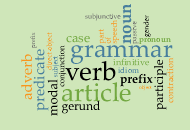|
 How to Teach the Present Progressive How to Teach the Present Progressive
The present progressive is a flexible tense in terms of what it can express. We can use it to express actions that are currently happening such as: “You are reading an article.” We can use it to express future actions: “Mohammed is taking a flight next Monday.” And we can use it for a recurring action that may not currently be taking place. For example, the sentence “Paola is studying at the university” depicts a continuous action she is engaged in, though she might not be at the university studying at this precise moment.
We must consider the formation of this tense in English and how the tense is used and created in our students’ native languages. The present progressive is formed by combining two verbs: the simple present conjugation of “to be” (e.g., I am, you are, s/he is…) and the present participle (e.g., walking, cooking, jogging). While some languages form the present progressive similarly to English (e.g., Italian, Spanish), other languages do not have an equivalent conjugation (e.g., German, French). Other languages have the present progressive but do not form it exactly as English does. For example, Danish has many ways of creating the progressive based on the verb itself. Even if students’ native language has the present progressive and forms it similarly to English, the progressive in their native language may not be used to express information in the same way English does. Chinese, for example, distinguishes between a current action: “I am putting on clothes,” which is conjugated differently than a current state “I am wearing clothes.”
Our students’ native languages may not contain the present progressive. If they do, the conjugation may not be formed similarly or the conjugation may not be used to express the same information. For these reasons, exploring the present progressive in our English classrooms is significant and lends itself to a myriad of interesting activities.
Materials Required
-
Paper and writing utensils for all students
-
Chalkboard, whiteboard, or doc cam
Timing: 25 minutes
Step 1
Review how the present progressive is formed with the present tense conjugation of the verb “to be” and the present participle. Explain that the present progressive can be used to express events occurring in the present moment, in the future, or for a recurring action not currently taking place. The following sentences may help your explanation (5 minutes):
Present moment: The dogs are sleeping on the front porch.
Future: Next Saturday, we’ll be sleeping in.
Recurring Action: The baby is sleeping through the night.
Step 2
Have students partner-up. With their partner, students will choose one verb, and write three sentences in the present progressive: one that expresses the present, one the future, and one a recurring action. (6 minutes)
Step 3
Partners will then form groups of four. In their groups of four, students will share the sentences they wrote with their partner. The group’s task is to select the most well-written sentence that expresses the present progressive. Students can edit sentences as necessary. One member of each group will write their best sentence on the board. (7 minutes)
Step 4
Each group of four presents their best sentence to the class by reading it and explaining how the present progressive is used. Students vote on which of the best sentences is truly the best. (7 minutes)
Optional Extension
This activity can be used in coordination with other class topics. For example, if you assign weekly vocabulary words, you could require that sentences incorporate one or more of them. If you would like students to further discuss a recent reading, you could ask that sentences focus on a specific topic or character.
Happy teaching,
Michelle
Dr. Michelle Jackson is the associate director of teaching at New Mexico State University’s (NMSU’s) Teaching Academy. She designs, develops, and delivers workshops on a variety of teaching and learning topics. Prior to NMSU, she was the manager of the English Language Institute at UT El Paso. She has taught English as a second language at UT El Paso and Harvard University as well as Spanish at UT Austin.
|